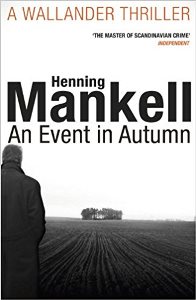Henning Mankell was a Swedish writer, playwright, and activist best known for his ‘Kurt Wallander’ series of crime novels. I’ve recently reviewed the first of the Wallander novels, Faceless Killers, here.

An Event in Autumn (Handen, 2013, translated by Laurie Thompson, originally published (in Dutch) as Het Graf, 2004) is a novella set a few years before Wallander’s retirement. It opens when his colleague Malinson, aware of Wallander’s interest in buying a rural property, asks if he would be interested in viewing a house belonging to his wife’s aged uncle who has recently moved into a care home. Wallander inspects the property: it’s distinctly run-down but otherwise seems to be the kind of thing he’s after, and the price is right. The sale doesn’t go ahead, however, because at the close of his inspection Wallander finds something unexpected protruding from the back lawn: a skeletal human hand. The hand bone’s connected to the arm bone, the arm bone’s connected et cetera … An investigation ensues. It transpires that the body’s been in the ground for forty or fifty years.
The pacing and overall tone in this one is rather reminiscent of Jorn Lier Horst’s When It Grows Dark (reviewed here), which is similarly brief and is similarly concerned with the investigation of a crime so long-concealed that very few witnesses remain, though the cynical and middle-aged Wallander is a much grumpier individual than Lier Horst’s keen young William Wisting. As ever, it’s the depth of the curmudgeonly Wallander’s characterisation, and the enveloping minutiae of the repeatedly-thwarted investigation, which convinces. It works well as a story; it would also function quite usefully as an introduction to Mankell, for those who might be put off ploughing straight into one of the longer books. (It’s also of interest for the dozen or so pages of explanatory material at the end, in which Mankell details the story’s origins as a publisher-requested ‘freebie’ to accompany Dutch sales of his crime novels, as well as outlining the origins of Wallander’s character—though this can be skipped over by those merely interested in the fiction, rather than the backstory.)